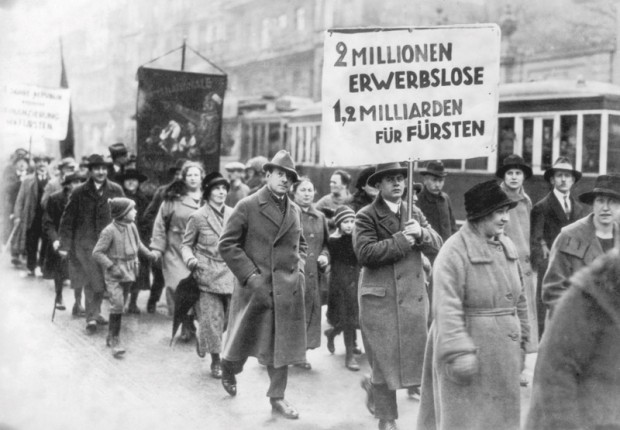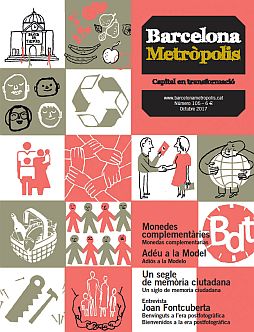The Austrian town of Wörgl’s local currency reactivated production and internal demand during the Great Depression. The Swiss WIR business cooperative’s credit system is another successful example of a complementary currency. WIR and the Kenyan mobile payments system, M-Pesa, are the only present-day examples that are having a macroeconomic impact.

Unemployed demonstration in Berlin, around 1930. In the context of the crisis and unemployment of the Great Depression, the currency of the Austrian town of Wörgl reactivated production and internal demand and had spectacular effects for jobs and public finance, while the rest of the continent continued to sink.
Photo: Hullom Archive / Getty Images
Dual and multi-currency monetary systems were the norm in a number of periods, including Ancient Egypt, Ancient Greece, throughout the Middle Ages and even in more recent times. While there have been many different types, they have often passed unnoticed by economic historiographers, despite the fact that they were stable and functional. In fact, mono-currency systems only began to predominate after the establishment of nation states and, even then, were not consolidated until well into the 20th century.
Although these systems are slightly less efficient due to the additional accounting complexities involved, they are more resilient and sustainable because they provide alternatives when a certain currency fails for one reason or another. When gold coins were used for international trade and to attract savings, and silver, bronze and copper coins, or those containing other less precious metals — such as the Castile billon and the French maille coins — were used in regional and daily local trade, the economy did not experience such a slowdown when a foreign trade deficit drained gold reserves, causing a lack of liquidity.
This article does not delve into Hayek’s arguments against monetary monopolies in The Decentralisation of Money (1976), nor into historical cases — interesting but from a bygone era — like those involving the Suffolk Bank of Massachusetts (1824-1858), the private multi-currency central bank; the Catalan rals, a monetary unit circulated during the 1640-1659 Catalan Revolt; or the numerous legal tenders (promissory notes or slips) introduced within Catalan cooperatives from the 19th century onwards.
Notwithstanding the various antecedents, we will begin this explanation with the case of the town of Wörgl, where the city council issued a local “currency” (known as “stamp scrips”) following the ideas established by Silvio Gesell in The Natural Economic Order (1919). Keynes devoted a section to the subject in General Theory of Employment, Interest and Money (1936), in which he said that “the future will learn more from the spirit of Gesell than from that of Marx”.
Confronting the Great Depression
The Wörgl currency (1932-1934) was supported by Austrian schillings deposited in a local savings bank. The city council put the currency into circulation by means of public spending, such as paying salaries and suppliers, and accepted it as payment for taxes. It could also be exchanged for conventional currency, although such transactions were penalised with a commission rate of 5 per cent. The driving forces behind the local currency introduced an innovative liquidity tax that devalued (depreciated) the currency’s value by 1 per cent every month so as to incentivise rapid spending, with the effect that the currency’s circulation rate increased fourteen-fold, thereby stimulating trade and local economic activity.
In the midst of the Great Depression, Wörgl had a very high unemployment rate and many families in the city endured situations of extreme poverty. The local currency reactivated production and internal demand, which led to a spectacular recovery in the areas of employment and public finance when the rest of the country and the wider continent continued on a downward spiral. The “miracle of Wörgl” inspired six neighbouring towns to copy its monetary system, and Édouard Daladier, the French Prime Minister, even paid a visit to see the currency in action on the ground.
Although the experiment was a resounding success in economic terms and more than 200 adjacent towns were already preparing to reproduce it, the Austrian Government, Central Bank and Supreme Court later outlawed it for political reasons: it was the initiative of a Social Democrat mayor at a time when fascism was on the rise. Without the local depreciable currency, the Great Depression returned to Wörgl and, with it, the desperation that provided the breeding ground for Nazism.
The case fascinated Yale professor and father of modern economics theory, Irving Fisher, who published the books Booms and Depressions (1932), which contained an appendix on Gesell’s theory, and Stamp Scrip (1933). Fisher championed this type of system in the United States, where, between 1932 and 1934, city councils, cooperatives and chambers of commerce created more than 300 similar systems, some using the devaluation technique.
As an adviser to Roosevelt, Fisher enthusiastically supported a public policy based on these systems, maintaining that if it were properly introduced it would solve the financial crisis in the USA in just three weeks. Unfortunately, the President prohibited its introduction — even in the private sector — owing to pressure from the wealthy elites and the bank, who preferred the New Deal tax increase over this decentralised currency revolution that they could not control (however, it was the preparations for the Second World War that ended the Great Depression, not the New Deal).
Meanwhile in Spain, in the context of limited liquidity during the Spanish Civil War, hundreds of similar local currencies were developed, although very few used the devaluation technique. In circulation on both sides, but predominantly among the Republicans and the Catalans, they worked well until Franco won the war and banned them (see examples at www.billetesmunicipales.com).
The WIR business credit cooperative
To continue with this introduction to the history of so-called complementary currencies, let us take a look at the most widely discussed and studied case: the Swiss Wirtschaftsring-Genossenschaft credit cooperative (Business Credit Cooperative or WIR-Bank), set up exclusively for SMEs and in operation since 1934. WIR-Bank acts as a commercial credit union, through which its more than 60,000 SME members nationwide can gain access to finance in the form of WIR francs at interest rates of less than 1 per cent. Issued in the form of loans, the currency cannot be converted to conventional money or devalued. The annual transaction volume of this multilateral exchange network amounts to 1.5 billion WIR francs, equivalent to Swiss francs.
Various studies, such as The Macro-Stability of Swiss WIR-Bank Credits, by Stodder and Lietaer (2016), demonstrate that this B2B system has a stabilising effect on macroeconomic cycles. During periods of economic boom, SMEs tend to prefer bank credit, so WIR-Bank activity is low; but during periods of recession, when bank interest rates rise, they turn to WIR credit. This has the effect of allowing SMEs to reduce their financial outlay while, at the same time, buying more from each other, thereby increasing internal demand and turnover for the companies involved. The WIR-Bank initiative helps reduce business mortality rates and maintain employment rates, with the result that national recessions can be better withstood. What is more, the system increases productivity by mobilising companies’ idle capacity, does not generate inflation during periods of growth and even has an anti-deflationary (positive) effect in times of recession.
WIR-Bank and the Kenyan mobile payments system, M-Pesa, based on prepaid balances, are the only present-day examples that are having a macroeconomic impact. There are, however, other initiatives that are also having a lot of success, such as the IRTA, an association serving English-speaking countries; Sardex in Italy; RES in Belgium; PuntoTRANSacciones in El Salvador; Banco Palmas in Brazil; and Bangla-Pesa, again in Kenya. The fact that they are working well shows the practical utility of complementary and local currencies, and provides valuable lessons for economic theory. A separate debate is whether or not these systems should be called “currencies”. Although that term, used for marketing reasons, can lead to confusion, these are entirely legal methods of payment.




